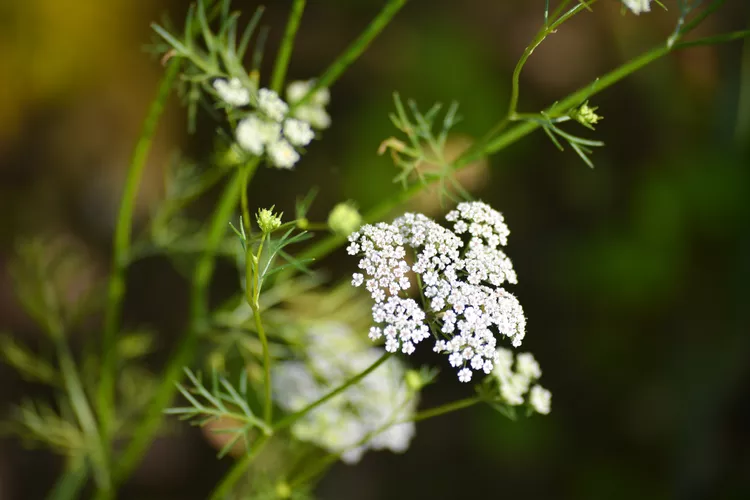Cumin is a popular culinary herb that is enjoyed mainly in Indian, Asian, and Mexican cuisines. Native to North Africa and Southwestern Asia, this annual plant is known for its seeds that provide a warm, slightly bitter flavor in curries, chilis, cheese, meats, and couscous. In some cultures, the crescent-shaped seeds are used like salt and pepper — sprinkled on prepared meals to add extra flavor and texture. The essential oil in the seeds is extracted and exported to the international market.
Cumin is most often used as a spice and it’s one of the essential ingredients of curry powder. It also has many other uses in the food, pharmaceutical, cosmetic, perfumery and soap industries. Each plant looks like a miniature version of dill and fennel, with similar soft, threadlike foliage.
Cumin Overview
| Genus Name | Cuminum cyminum |
| Common Name | Cumin |
| Plant Type | Annual, Herb |
| Light | Sun |
| Height | null to 1 Foot |
| Width | 2 to 6 Inches |
| Flower Color | Pink, White |
| Foliage Color | Blue/Green |
| Season Features | Summer Bloom |
| Propagation | Seed |
Where to Plant Cumin
Plant cumin in well-drained soil in full sun. In order for the plant’s seed to ripen, it must be grown in a mild climate with warm temperatures of at least 82°F for three to four months after it flowers. The plant is sensitive to wet or humid areas and it doesn’t tolerate windy conditions. This classical spice has been grown for many centuries in Egypt, Greece, Turkey, the Middle East, India, northern Europe, Morocco, Russia, Central America, China, and Japan.
How and When to Plant Cumin
Cumin plants are sensitive to cold. Start seeds indoors 4 to 6 weeks before the last frost, but before you plant them, soak the seeds for 8 hours to improve germination. Sow at least three seeds together on the surface of 65°F soil so the seeds will produce plants that can cross-pollinate in the future.
Care Tips for Cumin
The cumin plant requires a lot of care because it doesn’t like exposure to spring cold or wind and requires a long, warm growing season to produce the most seed. It also doesn’t like excessive heat or dry soil.
Light
Cumin grows best in full sun. Try to plant cumin where it will get at least 6 hours of direct sunlight a day.
Soil and Water
Cumin grows best in organically rich, well-drained soil and will not germinate in clay soil. As cumin matures, its top-heavy foliage on spindly stems is likely to be knocked over by wind or rain, so it’s important that the soil around the plant remains somewhat dry to decrease fungal risks associated with wet soil. As plants mature, water only when the top 1 to 2 inches of soil feel dry to limit plant disease.
Temperature and Humidity
Cumin is a tender herb that requires warm temperatures and freedom from all the possibilities of frost. Take plants outdoors after the last spring frost when temperatures are between 50°F to 80°F and weather is mild. A large amount of cumin can be grown in outdoor garden beds if you protect them under low polytunnels from cool or wet weather. If your growing environment is humid, plant each seedling at least 6 inches apart to limit fungal risks.
Pruning and Harvesting
Gather cumin seeds before they fall to the ground. You’ll know that the seeds are ready to be harvested when the seeds start browning and drying out. To harvest the seed heads, cut the stems and tie them together, then put the bundles in a paper bag and shake the plant to remove the seeds.
Pests and Problems
The peach green aphid is cumin’s most destructive pest. Since the aphid attacks the cumin plant during flowering, control it by using systemic pesticides such as metasystox or dimethoate, or contact pesticides such as diazinon, malathion, or gusathion.
Ants also commonly attack cumin by carrying away the plant’s seeds when the seeds are ready to be collected from its umbels. Be sure to harvest the plant’s seeds in a timely manner before the ants move in to cause destruction.
Weeds can also be a problem for cumin. The fine, upright, feathery foliage of young cumin plants can easily be overtaken by fast-growing weeds until the plants are mature and have a significant leaf mass.
How to Propagate Cumin
Start seeds indoors by sowing three to five seeds per pot. When seedlings are between one and two inches tall, remove all but the hardiest and nurture the remaining seedlings to maturity. When the cumin plants bloom and weather conditions are warm, place them outdoors in a wind-protected location, near other flowers to encourage insect pollination.




















